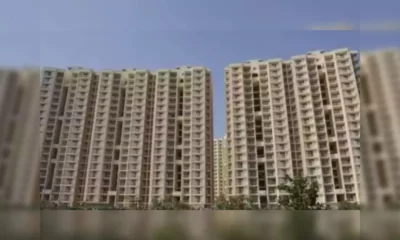News
Factors driving the growth of smart homes in India by Arvind Jain, MD – Pride Group


The following is the report by Arvind Jain, Managing Director – Pride Group
Smart homes are a major step on the evolutionary ladder for residential spaces, and their primary aim is to make living more comfortable, convenient, secure, entertaining and sustainable. Powered by gadgets and computing technologies, smart homes were the prerogative of the very rich in the past – but no more.
Today, smart home technologies have become affordable and every other average household uses some form of smart home automation or the other. Smart home as an end product from developers are also drawing more and more buyers in urban India. In integrated townships, smart home features are an expected advantage and considered a desirable part of the overall product offering.
Thanks to constant technological advancements, smart homes are also becoming ‘smarter’ with every passing year. Just a few years ago, smart Indian homes were primarily marketed as homes with advanced security features like cameras, smart door locking systems and similar surveillance. Today, the implications have expanded to include electronically enabled lighting systems, fire detection systems, gas leakage detection, energy efficiency monitoring, entertainment systems, etc.
Increasing Acceptance
In India, the market for smart homes has been growing steadily. Every year, the uptake of smart homes in India is increasing by between 15-18 per cent in tier 1 cities and by between 5-10 per cent in tier 2 and tier 3 cities. This dynamic has especially been driven by the increase in the number of working couples with dual incomes in metro cities. With both spouses working, a family is financially capable of opting for a smart home, which do cost a bit more than homes without smart features.
In particular, home automation is regarded as a desirable solution to keep homes safe while they are not occupied – either during the day when the inhabitants are at work, or for extended periods when they are vacationing. Smart surveillance features also allow the safety of children and elderly people to be monitored remotely via smartphone apps. In integrated townships, the smart security features must be integrated with the larger security measures at the project level.
Thanks to deeper Internet penetration and the rising concerns about home security amid the ever-escalating crime rates in our cities, most potential home buyers today are aware of the smart home concept. While this awareness is slightly lower in non-metro cities, the overall predisposition to this product is quite positive. In upper segment homes, smart home features are the norm rather than an exception – and, as already mentioned, homes in integrated townships are considered de rigueur.
The Most Popular Features in Indian Smart Homes
Security – Video door monitoring, motion sensors, gas leakage detection, Intrusion sensors, curtain sensors, fire detection and control
Lighting control – remote on/off, presence detection
Electrical – Smart air conditioning, smart refrigerators
Entertainment – AV controls, gaming consoles
Communication – GPS navigation connected to entry and exit, proximity door unlocking
For the average Indian buyer of a smart home, the unit home must above all include electronic security features. Energy efficiency is another aspect that is becoming increasingly popular among home buyers. People are willing to spend more for a smart AC, Smart TV or a smart refrigerator. However, advanced security has been the main driver.
In India, the barriers to large-scale acceptance of smart homes are crumbling. However, there are still some factors that hinder mass acceptance:
Cost – Smart technology-enabled homes cost more
Lower awareness – the older generation of home buyers are still not completely confident of the advantages of smart home features
Most Indian customers expect that smart technologies will add to the security of living in some way of the other; if it does not, the offering is close to unacceptable. Things like AC control or smart gadgets are considered desirable, but not an absolute necessity. The demand for technologies like video conferencing, communication across floors or even curtain control are largely limited to commercial spaces and are not yet a big factor in smart residential units in India.
While average Indian home buyers are positive to the idea of a smart home, they are willing to spend no more than 1-3 per cent extra for a home featuring smart solutions. The upper-income groups extend the premium acceptance to 5-8 per cent; which, it must be stated, is still low when seen in the light of the overall benefits available in smart homes.
Yet, things are definitely looking up in this space – awareness and acceptance levels are increasing, and in the near future, we will be getting closer to smart homes becoming the default choice for home buyers.
-



 News3 weeks ago
News3 weeks agoKW Delhi 6 Mall Onboards New Brands
-



 News3 weeks ago
News3 weeks agoManasum Senior Living Launches IKIGAI GOA, A Senior Living Community in North Goa, in collaboration with Prescon Homes
-



 News2 weeks ago
News2 weeks agoGodrej Properties Sells Rs 3k cr+ Homes of Godrej Zenith, Gurugram, within 3 days
-



 News3 weeks ago
News3 weeks agoBridging India Divide: Top 5 Tier- 2 Cities to Focus On
-



 News3 weeks ago
News3 weeks agoCommercial Realty Gets Tech Savvy: Fast Construction, Enhanced Convenience
-



 News3 weeks ago
News3 weeks agoMultipoint Connection – A Definite Boon
-



 News2 weeks ago
News2 weeks agoRBI’s Status Quo on Key Policy Rates to Help Maintain the Real Estate Growth Momentum, Say Industry Stalwarts
-



 News3 weeks ago
News3 weeks agoSacred Cities See a Retail Boom as Spiritual Tourism Surge: CBRE Report



















